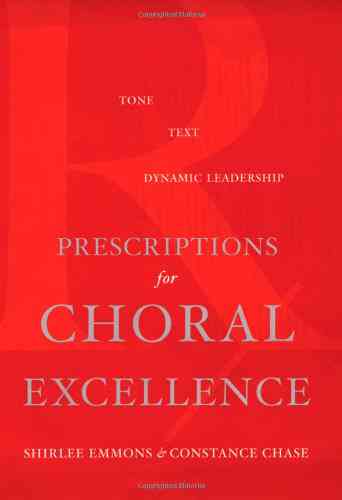
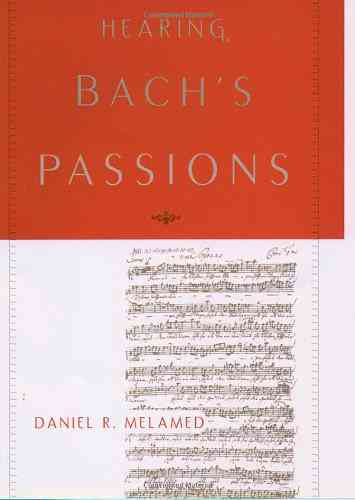

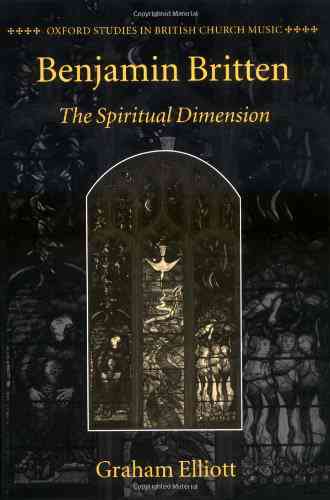
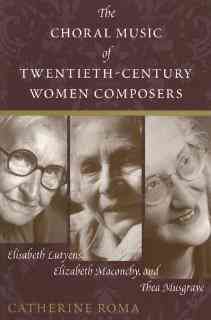
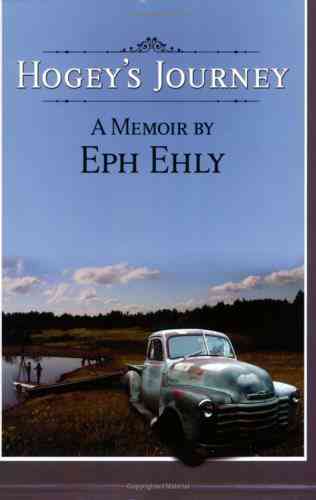 Prescriptions for Choral Excellence: Tone, Text, Dynamic Leadership, by Shirlee Emmons and Constance Chase. Oxford and New York: Oxford University Press, 2006. 334 p. ISBN 0-19-518242-1.
Prescriptions for Choral Excellence: Tone, Text, Dynamic Leadership, by Shirlee Emmons and Constance Chase. Oxford and New York: Oxford University Press, 2006. 334 p. ISBN 0-19-518242-1.
Hearing Bach's Passions, by Daniel R. Melamed. Oxford and New York: Oxford University Press, 2005. 178 p. ISBN 0-19-516933-6.
Bach: The Mass in B Minor, by George B. Stauffer. New Haven and London: Yale University Press, 2003. 311 p. ISBN 0-300-09966-5.
Benjamin Britten: The Spiritual Dimension, by Graham Elliott. Oxford and New York: Oxford University Press, 2006. 169 p. ISBN 0-19-816258-8.
The Choral Music of Twentieth-Century Women Composers: Elisabeth Lutyens, Elizabeth Maconchy, and Thea Musgrave, by Catherine Roma. Lanham, Maryland: The Scarecrow Press, 2006. 207 p. ISBN 0-8108-5029-X.
Hogey's Journey: A Memoir by Eph Ehly, by Eph Ehly. Dayton, Ohio: Heritage Music Press, 2006. 246 p. ISBN 0-89328-220-0.
The six titles under review are all in the field of choral music; they include one filled with a wealth of information for choral conductors, two on the music of Johann Sebastian Bach, one about the spiritual dimension of the music of Benjamin Britten, one concerning three important composers of the twentieth century, and finally a chronicle of the journeys of an inspirational choral conductor. Each of these books shares a common element: a sense of spirituality that challenges us to look beyond ourselves to find something better. They encourage us to build stronger musical ensembles and a better world. The recurring terms "soul" and "spirituality" do not necessarily imply only sacred thought, but also look at the core of humanity. Collectively these books contain a vast amount of information and illuminate different aspects of musical interpretation.
Choral directors are always seeking either new or tried and true ways for improving the sound of their choirs. In Prescriptions for Choral Excellence Shirlee Emmons and Constance Chase give choral directors and singers a detailed list of problems that may exist in various choral ensembles, a method for diagnosing these problems, and a list of remedies. Prescriptions could be viewed as a book for healing ailing choirs. It gives insight into how to improve music making by dealing with and fixing one problem at a time. It is laid out in a manner similar to many diagnostic medical texts of the 1970s. In the preface, the authors give an explanation on "How to Use This Book," a section which effectively sums up the layout:
Each chapter opens with a table of contents for that chapter, showing the major sections. Each chapter section commences with a short overview of the subject. We have borrowed terms from the medical profession to address the vocal skills and leadership issues (v).
The authors actually use the terms "The Complaint," the "Diagnosis," and the "Treatment Plan" in their book. The rationale for each treatment is backed up with scientific background.
Part 1 covers technical vocal skills, and is broken down into six areas: 1) Breath Management, 2) Diction and Intelligibility, 3) Tone, 4) Intonation, 5) The Individual Singer, and 6) The Warm-Up and Training Period. The authors lead the reader though a series of practical solutions to improving each of these areas.
Part 2 addresses the choral conductor's self-development in terms of preparation, development, and execution. Chapter six, which deals with leadership issues, is filled with practical information to help the conductor develop a "best" leadership style, as well as ways to enhance the cohesion of a choral ensemble. The discussions in this chapter are especially useful. The first concerns the social theory of groups and the four stages they experience: forming, storming, norming, and performing. The material can be extremely beneficial in identifying the stage of a particular ensemble and likewise help the director develop skills for dealing with each phase of development.
The seventh chapter deals specifically with leadership theory, and covers general principles of leadership, motivation, and discovering leadership styles. The second part of the chapter deals with the idea of followers and individual roles within groups, both functional and dysfunctional. Finally, the authors offer tools for leading a choral group, setting goals, and resolving conflict. Particular importance is placed on the ability to diagnose the problems of both individual singers and entire sections, thus aiding the director in developing a coping strategy.
Practice and imagery skills are discussed in detail in chapter eight. It opens with a discussion of the nature of practice and rehearsal, and includes an in-depth analysis of practice types and strategies to develop musicianship. This is followed by principles and strategies for memorizing music, again broken into stages: perception, encoding, storage, and retrieval. Great care is taken to explain when it is best to work with your singers on memorizing the music, and that when they are rushed, tired, frustrated, and the like, memorization will be less effective. The remainder of the chapter explains a performance mode of rehearsal, a method through which singers focus minimal attention on technical skills, as these will become automatic through efficient rehearsal techniques. Building interpretive skills into the rehearsal process along with technical skills will allow the conductor the opportunity to make interpretive decisions in performance. The chapter concludes with a discussion of imagery and how to effectively practice it with an ensemble.
Chapter nine focuses on improving the mental skills of both conductors and singers. The opening sections deal with relaxation techniques that enable conductors to gain peak mental performance. Next is a discussion of setting goals (both subjective and objective) and the importance of setting appropriate goals for both conductors and ensembles using the acronym SMARTER: Specific, Measurable, Acceptable and Adjustable, Realistic, Time-phased, Exciting, and Recorded. The book concludes with information on dealing with anxiety and maintaining self-confidence, important topics for both conductors and singers.
Practical, useful information also appears in the appendices. The first concerns recommendations from vocal health professionals on how to keep the voice healthy and includes restorative and preventative measures. Second is a copy of "Stemple's Vocal Function Exercises," a type of physical therapy for the vocal folds designed to strengthen and balance laryngeal musculature and aid the singer in developing a balance between airflow and muscular effort. Third is a copy of the Performance Profile Chart mentioned in the text, followed by reprints of the American Academy of Teachers of Singing statements on "Choral Tessituras" and "Early Music and the Absence of Vibrato."
Moving from techniques of choral singing to the music itself, the first book to be discussed is Hearing Bach's Passions by Daniel R. Melamed, who in the introduction, poses the question of "when we listen to a Bach passion, is it really the same piece Bach wrote in the early eighteenth century?" (3) The author asserts that many times when we are striving to have an "authentic" performance of the music we miss out on the intent of the original composition. Who were the Passions composed for and what reactions were they expected to elicit from the listener? Melamed calls for the need to focus more on the intent of the music and to investigate the physical and practical differences between how we view the Passions today versus how they were viewed during Bach's day.
Melamed begins by examining the performing forces and performance history of the Passions during Bach's lifetime. Although this material can be found in many other sources, it is arranged here in a very easy to follow format. First, Melamed discusses the vocal forces Bach used. Then he questions whether or not these singers played a dramatic part for the listeners of the time, or were merely conveying the text. Melamed presents considerable evidence that Bach and his listeners did not directly associate individual singers with their characters, which left singers free to do many different things during the course of a Passion performance, depending on the setting. This interpretation allows today's performers tremendous flexibility in recreating the Passions, and will certainly stimulate conversation regarding performance practice.
The second section of the book focuses on the works themselves. The chapters examine double chorus scoring, multiple versions of a single composition (the St. John Passion), and the eighteenth-century practice of assembling "pastiche" passion settings by adding or substituting moments.
The first chapter in this section focuses on the concept of the double chorus in the St. Matthew Passion. Melamed discusses how the work is judged by how it most often is performed in the present, rather than how Bach and listeners in the 1740s interpreted the work. He states: "The design of Bach's original performing materials for this composition suggests that the St. Matthew Passion was performed by eight principal singers, each of whom sang arias and who joined together in groups of four to form the two choruses." (51) Melamed surmises that the double-chorus disposition plays a much smaller role than is often thought.
The St. John Passion and all of its various versions is the focus of the following chapter. The author begins his investigation by discussing why different versions of a work may appear and how we can decide which is the most correct. Ultimately, the decision comes down to opinion or aesthetic judgment, and Melamed uses the St. John Passion as a test case for how to deal with multiple versions. Bach constructed at least four versions of the work, taking music from a "large stack of vocal and instrumental parts." (68) Within the chapter an attempt is made to reconstruct each of these versions, and the author sums up the chapter by stating: "We are increasingly interested in the meanings and messages of compositions like Bach's passions . . . and if we feel enriched by Bach's setting of the St. John Passion, imagine the treasure represented by four (or more) of them." (77)
The next chapter takes an in-depth look at the St. Mark Passion, a work that has long been attributed to Reinhard Keiser, and which Bach changed and adapted for use in Leipzig during the 1740s. Melamed looks at the eighteenth-century practice of reworking passion settings for performances in various times and places (much of which is also discussed elsewhere in the book). Surviving sources show at least five pastiched versions of the work, each one an adaptation for particular needs. Looking from this point of view, the role of Bach as a church musician who needs to turn out a regular set of performances for the various services of the liturgical year becomes apparent.
The third large section of the book discusses the "Phantom Passions," looking first at the St. Mark Passion BWV 247 and then the St. Luke Passion BWV 246. The first chapter in the section details the attempt to reconstruct the St. Mark, partially allowing a "fresh immersion" into Bach's compositional art. Within the chapter he discusses how Bach parodies his own music by reworking entire compositions or by taking movements from various compositions to create a new one. Was the St. Mark really a parody of other works or entirely a new composition? Melamed concludes the chapter stating "the various 'reconstructed' versions of the St. Mark Passion are perhaps best thought of as modern pastiches in the eighteenth-century tradition." (110)
The next chapter concerns the authorship of the St. Luke Passion. This work for years was attributed to Bach, but through a series of examples Melamed addresses the confusion surrounding this assertion, and concludes that along with the other Passions, it should remain part of the repertory of a highly effective church musician.
In the epilogue Melamed describes his journey through Bach's Passions as "worth the effort." (131) This study gives performers greater confidence to interpret the works with a broader vision of their function and purpose: "The point here is not historical rightness or wrongness of any given way of performing but a question of the distance of a given performance from practices of the early eighteenth century. Narrowing this distance is important if we want to get a little closer to Bach and to his music." (134)
The next book to be surveyed focuses on a single work: Bach's Mass in B Minor. Author George Stauffer describes the work as "The Great Catholic Mass," and places it within the context of its time.
The first chapter offers a survey of the late Baroque church mass. Within the chapter he refers to several mass settings by Caldara, Furante, and Zelenka that may have influenced Bach's own setting. In addition, Stauffer surveys musical developments of the period, including the Lutheran practices in Leipzig, and gives an overview of mass writing in Dresden.
In the next chapter, Stauffer describes how Bach parodies his own music and thereby creates a new work. He states that "in recent times Bach scholars seem to agree that the B-Minor Mass contains very little, if any, fully original music" but is a "supreme testament" to Bach's ability as a composer. (49-50) The third, fourth, and fifth chapters go into great detail about the form, structure, harmonic concepts, use of stylistic contrasts, and expressive elements that Bach uses for each movement. In addition, the author discusses how the composer uses vocal and instrumental colors to create variety. These three chapters are worth the price of the book for anyone preparing the work for performance.
A report of how the Mass in B Minor evolved from a "historical curiosity" to a mainstay of choral repertoire is the focus of chapter six. Stauffer details the surviving manuscript materials and the first performances of the work after Bach's death, as well as its revival in the nineteenth century. This leads into the seventh chapter's discussion of performance practice, which addresses continuo, articulation, tempo, vocal forces, and pronunciation. The final chapter presents the work as a whole in relation to style, structure and unity. The author makes a strong case for the universality of the work and why it should be considered one of the monuments of choral music
Moving to the twentieth century, Graham Elliott's Benjamin Britten: The Spiritual Dimension demonstrates that within the music of Britten, a clearly defined pattern of spiritual influence takes place and that through this influence, Britten's music is able to embrace a variety of universal concerns. Elliott wants to portray a more complete picture of Britten and venture beyond discussions of his homosexuality and pacifism.
The book is broken down into two parts: the first is an overview of his life and influences, while the second is a survey of his music. The first chapter of part one is an introduction to the overall concept of the spiritual dimension of Britten's music. Elliott discusses the paradox that Britten at times is insistent on the Christian message in some of his works, but that "it must be acknowledged . . . that a strong moral sense does not imply a deeply Christian personality" but someone with a spiritual drive. (5)
Chapter two focuses on Britten's boyhood, a time that was filled with a strong presence of the church in addition to a strong family life. His first music teacher was his mother, who in turn had a strong influence over his early and formative years. The remainder of the chapter lists the variety of teachers, musicians, and churches that filled Britten's early life, as well as the environment that fostered his creativity, including his studies with Frank Bridge.
The third chapter focuses on two churchmen who were extremely influential to Britten: the Very Reverend Walter Hussey (1909-1985) and Bishop Leslie Brown (1912-1999). Hussey's belief in the importance of art within the total life of the Church greatly affected Britten, and Hussey remained a close friend to Britten until the end of the composer's life. Brown, whose admiration for Britten was boundless, is described in the book as a "spiritual mentor" (24) in whom Britten found a "trusted and wise pastor with whom he was able to share his spiritual quest." (25)
Chapter four is devoted to the observations and influence of Sir Peter Pears, who agreed that Britten's strong moral sense was essential to his spiritual identity. Pears promoted the idea that Britten's religious feelings were fired by specific texts and that his faith was driven by the texts he chose to set. Elliott concludes the section by summarizing the previous chapters and asserting that Britten's artistic output is a result of all the influences in his life and that limiting the view of Britten to any one area (including spirituality) produces an incomplete view of the composer and his work.
The second part of the book focuses on spiritual dimensions in selected works by Britten. Chapter 6 is a study of his plainsong and hymn tunes, chapter 7 concerns the liturgical music, and chapters 8 through 11 focus on the so-called "parable music," works that impart important lessons through music. Chapter 12 offers a summation of the book and the various ways in which Britten's spirituality can be interpreted. These discussions are immensely useful for anyone preparing Britten's works for performance.
In The Choral Music of Twentieth-Century Women Composers: Elisabeth Lutyens, Elizabeth Maconchy, and Thea Musgrave, Catherine Roma explores the diverse approaches used by these and other contemporary composers. The work is valuable for its information alone on the choral works represented. It also highlights three British-born composers frequently overlooked because of their gender. All three wrote in many genres, but choral music constitutes an important part of their output.
The book is arranged in five chapters: an introduction, discussions of the choral music of the three composers listed in the book's title, and a survey of other twentieth-century British women composers. The introduction details settings in which these three composers lived and worked. It consists of two main sections: the first concerns the English Musical Renaissance and the revival of British choral music, while the second focuses on the roles of women in music during the first two decades of the twentieth century. Subsequent chapters focus on each composer and provide an invaluable resource for the conductor studying their works and looking for new literature. In addition to analyses, background is given for each work. The concluding chapter addresses the life and work of female composers who were contemporaries of Lutyens, Maconchy, and Musgrave: Phyllis Tate, Grace Williams, Priaulx Rainier, Nicola LeFanu, and Judith Weir.
Hogey's Journey: A Memoir by Eph Ehly forms a fitting conclusion to this survey of recent books on choral music. It tells of the life and career of conductor and educator Eph Ehly, told as an allegorical story interwoven with words of wisdom and true life experiences. As one of Ehly's former students, there are not enough words to sum up the value and meaning of his text. Many of the stories he told in classes are captured here for all to read. He imparts new wisdom on each page and allows the reader to experience his vibrant teaching style and his gregarious view on life in general.
Following the precepts of musical form, the book is in an ABA' structure. The A section, "Living to Learn," is told through the eyes of Hogey, a character that is part Ehly and part his father. The other two main characters are the author's grandchildren, Becky and Matt. The importance of family is the dominant theme in this part of the book. As the story unfolds, the reader is reminded that humans grow and learn from all of their surroundings, and that we must learn to keep open eyes and minds.
"Learning to Teach," the B section, focuses on a particular time in Eph Ehly's life, the days when he was just starting out as a teacher. He recalls former students from whom he learned important life lessons and through whose lives he learned the importance of getting to know his students. Ehly offers many pieces of sage advice in these pages. For example, he writes that we may learn as much from our students as we teach them (121) and it is better to discover a truth rather then to be told it. (123) He also reminds his readers that great quality music will do a great deal for the soul and can increase our humanity. (132)
"Teaching to Learn How to Live" constitutes the modified reprise of the A section, and returns to the allegory and its characters, all of whom have learned how to live and have taught important truths to each other. As Ehly asserts, "Music helps us transcend from what we see and hear to what we feel as real. Music helps us harmonize the living in the physical world with the living in the spiritual world." (195) The subtitle of the final chapter sums up the book, "Teaching by doing is better than teaching by preaching."
These six titles concerning choral music all reflect the transcendent power of music. Whether they be practical suggestions for achieving a desired choral sound, investigations into the works of five significant choral composers (Bach, Britten, Lutyens, Maconchy, and Musgrave), or the aesthetic ideas of a choral conductor, the themes of all of these books are extremely useful resources for anyone concerned about improving the quality of musical performance.


